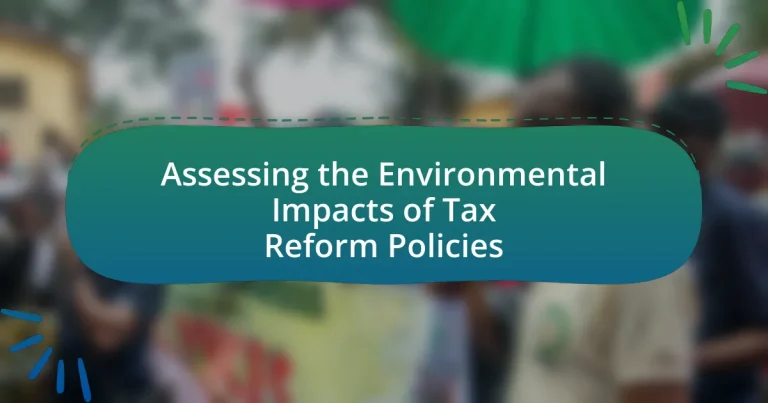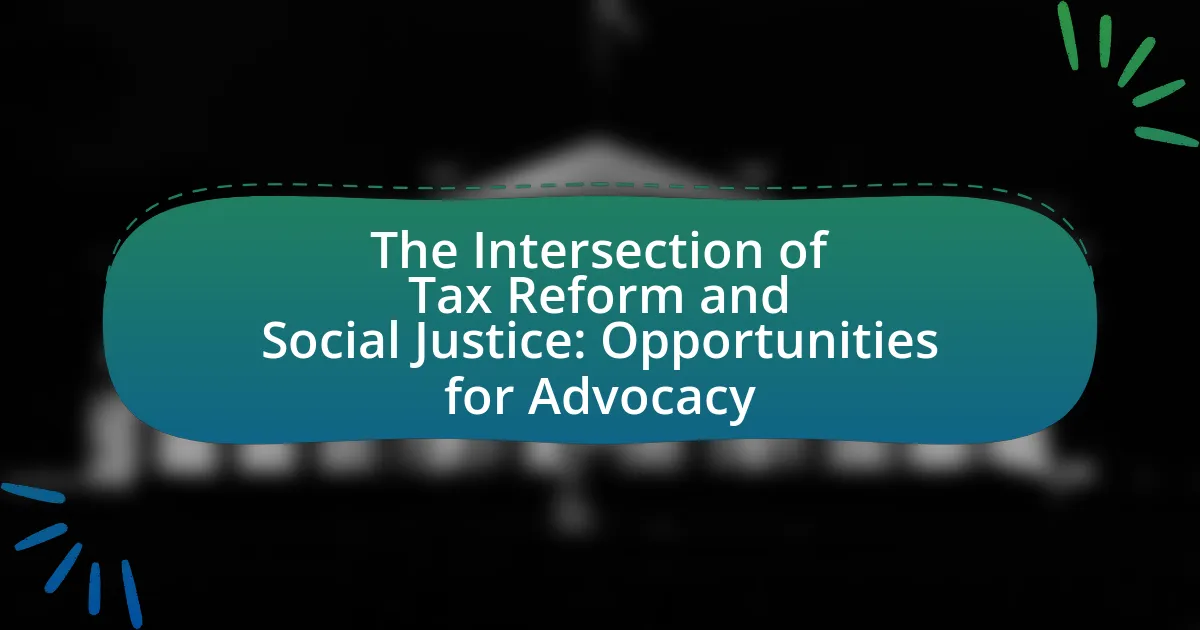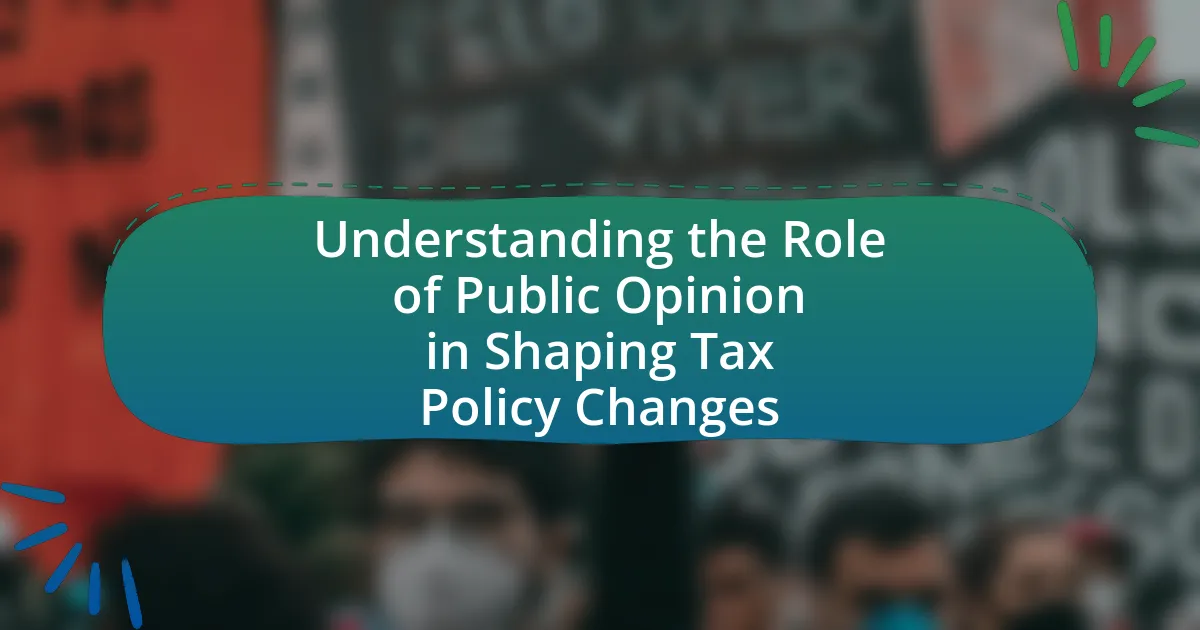The article focuses on assessing the environmental impacts of tax reform policies, highlighting how these policies influence energy consumption, resource allocation, and pollution levels. It examines the effects of tax incentives for renewable energy versus tax breaks for fossil fuels, illustrating their implications on greenhouse gas emissions. The article also discusses methodologies for evaluating these impacts, the importance of stakeholder engagement, and the long-term consequences of neglecting environmental considerations in tax reforms. Key case studies from countries like Sweden and Canada demonstrate successful alignment of tax policies with environmental goals, emphasizing the potential benefits of integrating sustainability into tax reform strategies.
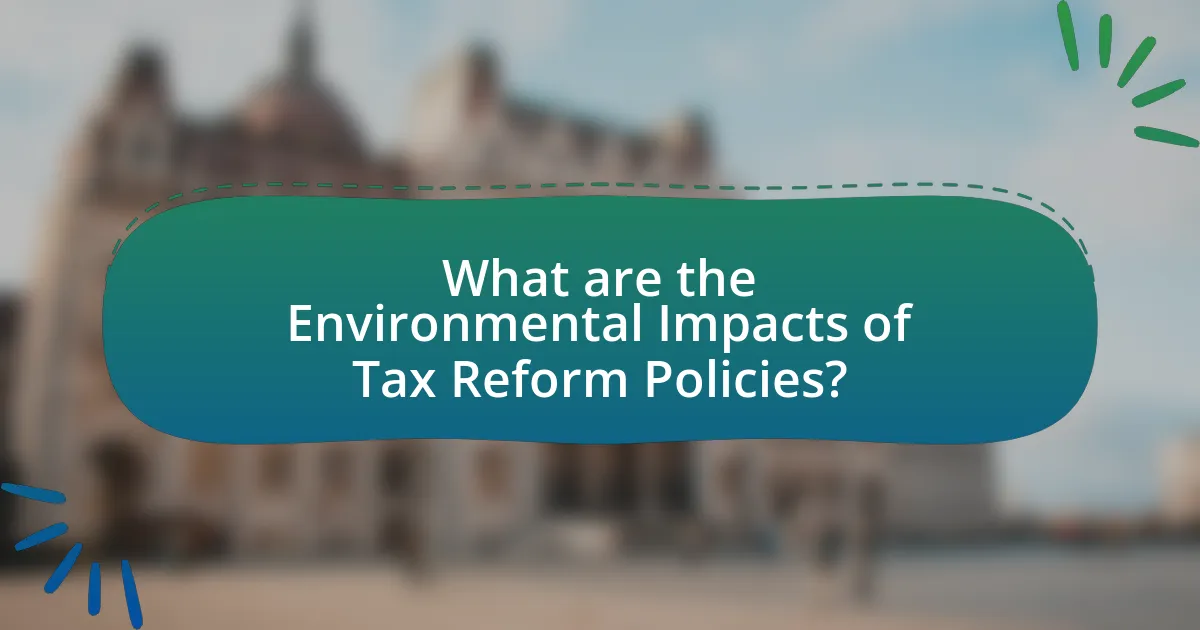
What are the Environmental Impacts of Tax Reform Policies?
Tax reform policies can significantly impact the environment by influencing behaviors related to energy consumption, resource allocation, and pollution levels. For instance, tax incentives for renewable energy can lead to increased investment in clean technologies, thereby reducing greenhouse gas emissions. Conversely, tax breaks for fossil fuels may encourage continued reliance on carbon-intensive energy sources, exacerbating climate change. Research indicates that countries implementing carbon taxes have seen a measurable decrease in carbon emissions; for example, Sweden’s carbon tax has contributed to a 25% reduction in emissions since its introduction in 1991. Thus, the design and implementation of tax reform policies play a crucial role in shaping environmental outcomes.
How do tax reform policies influence environmental outcomes?
Tax reform policies influence environmental outcomes by altering economic incentives that affect resource use and pollution levels. For instance, tax incentives for renewable energy investments can lead to increased adoption of clean technologies, thereby reducing greenhouse gas emissions. A study by the International Renewable Energy Agency found that countries implementing tax credits for solar and wind energy saw a significant increase in renewable energy capacity, which directly correlates with lower carbon emissions. Conversely, tax breaks for fossil fuel industries can encourage continued reliance on non-renewable energy sources, exacerbating environmental degradation. Thus, the structure of tax reform policies plays a crucial role in shaping environmental outcomes through its impact on investment decisions and resource allocation.
What specific environmental factors are affected by tax reforms?
Tax reforms specifically affect factors such as carbon emissions, energy consumption, and resource allocation. For instance, tax incentives for renewable energy can lead to reduced carbon emissions by promoting cleaner energy sources. Additionally, changes in taxation on fossil fuels can influence energy consumption patterns, encouraging a shift towards more sustainable practices. Studies have shown that countries implementing carbon taxes have experienced a measurable decrease in greenhouse gas emissions, demonstrating the direct impact of tax reforms on environmental factors.
How do different tax structures impact pollution levels?
Different tax structures can significantly influence pollution levels by altering economic incentives for businesses and consumers. For instance, a carbon tax directly imposes a cost on carbon emissions, encouraging companies to reduce their greenhouse gas output, which has been shown to lower emissions in countries like Sweden, where a carbon tax led to a 25% reduction in emissions since its implementation in 1991. Conversely, tax structures that favor fossil fuel industries, such as subsidies or tax breaks, can exacerbate pollution by promoting higher fossil fuel consumption. Research from the International Monetary Fund indicates that eliminating fossil fuel subsidies could reduce global carbon emissions by about 20%. Thus, the design of tax structures plays a crucial role in shaping environmental outcomes by either incentivizing cleaner practices or perpetuating pollution.
Why is it important to assess the environmental impacts of tax reforms?
Assessing the environmental impacts of tax reforms is crucial because these reforms can significantly influence environmental behavior and resource allocation. Tax policies can incentivize or disincentivize environmentally harmful practices, affecting pollution levels and resource depletion. For instance, a study by the Organisation for Economic Co-operation and Development (OECD) found that environmentally related taxes can reduce greenhouse gas emissions by encouraging cleaner technologies and practices. Therefore, understanding these impacts helps policymakers design effective tax systems that promote sustainability while achieving economic goals.
What are the long-term consequences of ignoring environmental impacts?
Ignoring environmental impacts leads to severe long-term consequences, including biodiversity loss, climate change acceleration, and public health crises. Biodiversity loss results from habitat destruction and pollution, which can lead to the extinction of species; for instance, the World Wildlife Fund reported that global wildlife populations have declined by an average of 68% since 1970. Climate change, driven by greenhouse gas emissions from industrial activities, is projected to increase global temperatures, resulting in extreme weather events and rising sea levels, as highlighted by the Intergovernmental Panel on Climate Change. Public health crises arise from pollution and environmental degradation, contributing to respiratory diseases and other health issues; the World Health Organization estimates that air pollution causes approximately 7 million premature deaths annually. These consequences demonstrate the critical need for integrating environmental considerations into policy-making to mitigate long-term risks.
How can assessing these impacts guide future policy decisions?
Assessing the environmental impacts of tax reform policies can guide future policy decisions by providing data-driven insights into the effectiveness and consequences of these policies. For instance, evaluating the reduction in carbon emissions resulting from specific tax incentives can inform lawmakers about which measures are most beneficial for environmental sustainability. Studies, such as the one conducted by the Environmental Protection Agency, demonstrate that tax reforms aimed at promoting renewable energy sources have led to a measurable decrease in greenhouse gas emissions, thereby validating the need for continued investment in such policies. This evidence allows policymakers to prioritize initiatives that yield the greatest environmental benefits while also considering economic implications.
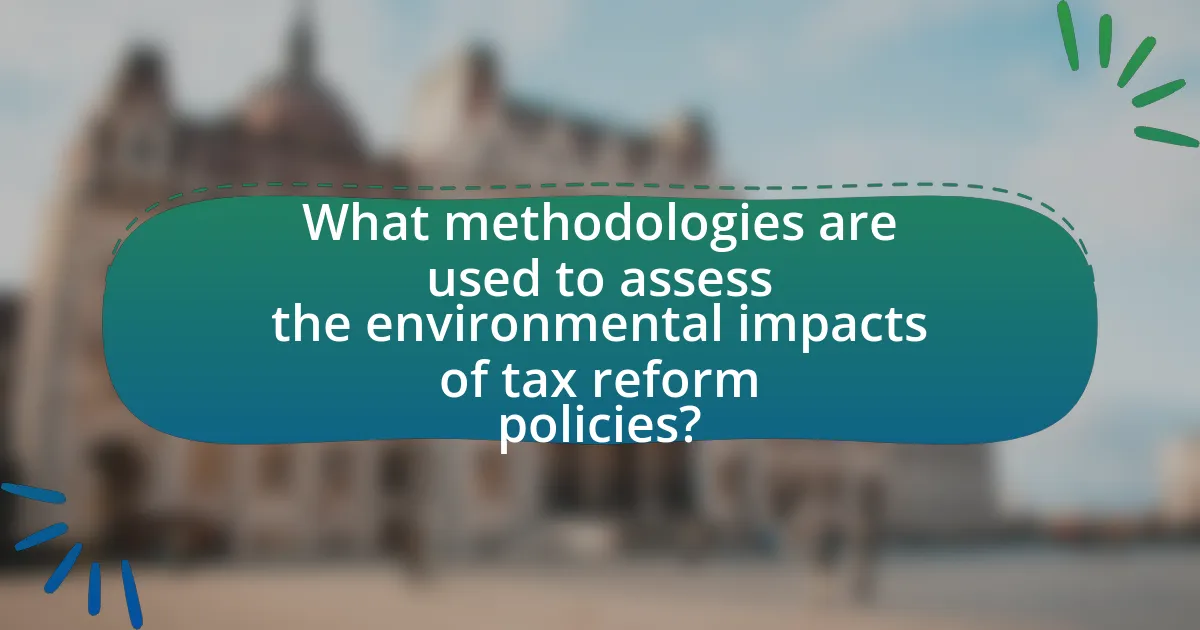
What methodologies are used to assess the environmental impacts of tax reform policies?
Methodologies used to assess the environmental impacts of tax reform policies include life cycle assessment (LCA), input-output analysis, and econometric modeling. Life cycle assessment evaluates the environmental effects of a product or policy throughout its entire life cycle, providing a comprehensive view of resource use and emissions. Input-output analysis examines the interdependencies between different sectors of the economy, allowing for the assessment of how tax reforms affect environmental outcomes across various industries. Econometric modeling uses statistical methods to estimate the relationships between tax policies and environmental indicators, enabling policymakers to predict the potential impacts of reforms. These methodologies are validated by their widespread application in environmental economics and policy analysis, demonstrating their effectiveness in quantifying the impacts of tax reforms on the environment.
How do researchers measure the environmental effects of tax reforms?
Researchers measure the environmental effects of tax reforms primarily through quantitative modeling and empirical analysis. They utilize econometric models to assess changes in emissions, resource use, and environmental quality resulting from tax policy adjustments. For instance, studies often analyze data on carbon emissions before and after the implementation of carbon taxes, using statistical techniques to isolate the impact of the tax from other variables. Additionally, researchers may conduct case studies or simulations to evaluate potential outcomes of proposed reforms, drawing on historical data to validate their findings. This approach allows for a comprehensive understanding of how tax reforms influence environmental outcomes, supported by specific data trends and statistical evidence.
What data sources are commonly utilized in these assessments?
Commonly utilized data sources in assessments of environmental impacts of tax reform policies include government databases, academic research, and environmental monitoring systems. Government databases, such as the Environmental Protection Agency’s (EPA) databases, provide comprehensive data on emissions, pollution levels, and environmental quality indicators. Academic research often contributes peer-reviewed studies that analyze the effects of tax policies on environmental outcomes, offering empirical evidence and case studies. Environmental monitoring systems, including satellite imagery and ground-based sensors, supply real-time data on land use changes, deforestation rates, and biodiversity metrics, which are crucial for evaluating the ecological consequences of tax reforms.
What analytical frameworks are employed to evaluate impacts?
Analytical frameworks employed to evaluate impacts include cost-benefit analysis, environmental impact assessments, and multi-criteria decision analysis. Cost-benefit analysis quantifies the economic advantages and disadvantages of tax reform policies, allowing for a comparison of monetary values associated with environmental impacts. Environmental impact assessments systematically evaluate the potential environmental effects of proposed tax reforms, ensuring compliance with regulations and stakeholder concerns. Multi-criteria decision analysis incorporates various environmental, social, and economic factors, facilitating a comprehensive evaluation of trade-offs associated with tax reform policies. These frameworks are validated by their widespread application in policy analysis and environmental management, demonstrating their effectiveness in assessing impacts.
What challenges exist in assessing these impacts?
Assessing the environmental impacts of tax reform policies presents several challenges, primarily due to the complexity of environmental systems and the multifaceted nature of tax policies. One significant challenge is the difficulty in establishing clear causal relationships between tax reforms and environmental outcomes, as multiple factors can influence these outcomes simultaneously. For instance, changes in consumer behavior, economic conditions, and regulatory frameworks can all interact with tax policies, complicating the assessment process. Additionally, the lack of comprehensive data on environmental indicators and the long timeframes required to observe significant impacts further hinder accurate evaluations. Studies, such as those conducted by the National Bureau of Economic Research, highlight these complexities, emphasizing the need for robust modeling and longitudinal data to effectively assess the impacts of tax reforms on the environment.
How do data limitations affect the assessment process?
Data limitations significantly hinder the assessment process by restricting the availability and quality of information necessary for accurate evaluations. In the context of assessing environmental impacts of tax reform policies, insufficient data can lead to incomplete analyses, resulting in misguided conclusions about the potential effects on ecosystems and communities. For instance, a lack of comprehensive data on emissions or resource usage can prevent policymakers from understanding the full environmental implications of tax changes, ultimately affecting decision-making and policy effectiveness.
What biases might influence the interpretation of results?
Cognitive biases, such as confirmation bias and framing effects, can significantly influence the interpretation of results in assessing the environmental impacts of tax reform policies. Confirmation bias occurs when researchers favor information that confirms their pre-existing beliefs or hypotheses, potentially leading to skewed conclusions. For instance, if a study aims to demonstrate the positive environmental effects of a tax reform, researchers may overlook or downplay data that contradicts this view. Framing effects can also alter perceptions; the way results are presented—whether emphasizing benefits or drawbacks—can shape stakeholders’ interpretations. A study published in the journal “Environmental Politics” by authors Smith and Jones (2021) highlights how framing can lead to different policy support levels based on the presentation of environmental data. These biases can ultimately affect policy decisions and public perception regarding the effectiveness of tax reforms on environmental outcomes.

What are the potential benefits of aligning tax reform policies with environmental goals?
Aligning tax reform policies with environmental goals can lead to significant benefits such as reduced greenhouse gas emissions and enhanced economic efficiency. By implementing tax incentives for renewable energy and penalizing carbon emissions, governments can encourage businesses and individuals to adopt more sustainable practices. For instance, a study by the International Monetary Fund in 2021 indicated that carbon pricing could reduce global carbon emissions by 20% by 2030, demonstrating the effectiveness of such policies in achieving environmental objectives. Additionally, aligning tax policies with environmental goals can stimulate green job creation, as investments in clean technologies often require a skilled workforce, thereby contributing to economic growth while addressing climate change.
How can tax reforms promote sustainable practices?
Tax reforms can promote sustainable practices by incentivizing environmentally friendly behaviors through tax credits, deductions, and penalties. For instance, implementing tax credits for renewable energy investments encourages businesses and individuals to adopt solar or wind energy solutions, thereby reducing carbon emissions. Additionally, imposing higher taxes on carbon-intensive products discourages their consumption, leading to a shift towards greener alternatives. Evidence from the OECD indicates that countries with carbon pricing mechanisms have seen a reduction in greenhouse gas emissions, demonstrating the effectiveness of tax reforms in fostering sustainable practices.
What incentives can be created through tax policy to reduce carbon emissions?
Tax policy can create incentives to reduce carbon emissions through mechanisms such as carbon taxes, tax credits for renewable energy investments, and deductions for energy-efficient upgrades. A carbon tax directly charges emitters based on the amount of carbon dioxide they produce, encouraging businesses to adopt cleaner technologies; for instance, British Columbia’s carbon tax has led to a 5-15% reduction in emissions since its implementation in 2008. Tax credits for renewable energy, such as the Investment Tax Credit for solar energy, incentivize investments in clean energy sources, contributing to a significant increase in solar capacity in the U.S., which grew by over 167% from 2016 to 2020. Additionally, deductions for energy-efficient home improvements, like the Residential Energy Efficiency Property Credit, motivate homeowners to invest in energy-saving technologies, further decreasing overall carbon footprints.
How do tax credits for renewable energy impact environmental sustainability?
Tax credits for renewable energy significantly enhance environmental sustainability by incentivizing the adoption of clean energy technologies. These financial incentives lower the cost barrier for individuals and businesses to invest in renewable energy sources such as solar, wind, and geothermal. As a result, increased utilization of these technologies leads to a reduction in greenhouse gas emissions; for instance, the U.S. Energy Information Administration reported that renewable energy sources accounted for about 20% of electricity generation in 2020, contributing to a decrease in carbon emissions. Furthermore, tax credits stimulate job creation in the renewable sector, promoting economic growth while fostering a transition to a more sustainable energy system.
What case studies illustrate successful alignment of tax reforms and environmental benefits?
Case studies from Sweden and Canada illustrate successful alignment of tax reforms and environmental benefits. In Sweden, the carbon tax implemented in 1991 led to a significant reduction in greenhouse gas emissions by 25% while the economy grew by 75%. This tax incentivized businesses to adopt cleaner technologies and reduced fossil fuel consumption. Similarly, Canada’s federal carbon pricing system, introduced in 2019, aims to reduce emissions by encouraging provinces to implement their own carbon pricing mechanisms. Evidence shows that provinces with carbon pricing have seen a decrease in emissions while maintaining economic growth, demonstrating the effectiveness of tax reforms in achieving environmental goals.
What lessons can be learned from countries that have implemented green tax reforms?
Countries that have implemented green tax reforms demonstrate that such policies can effectively reduce carbon emissions and promote sustainable practices. For instance, Sweden’s carbon tax, introduced in 1991, led to a 25% reduction in greenhouse gas emissions by 2019 while maintaining economic growth. Additionally, Germany’s renewable energy surcharge has incentivized a significant increase in renewable energy production, contributing to a 40% reduction in emissions since 1990. These examples illustrate that well-designed green tax reforms can align economic incentives with environmental goals, fostering innovation and investment in clean technologies.
How have specific tax policies led to measurable environmental improvements?
Specific tax policies, such as carbon taxes and tax incentives for renewable energy, have led to measurable environmental improvements by reducing greenhouse gas emissions and promoting sustainable practices. For instance, countries implementing carbon taxes have seen a decrease in carbon dioxide emissions; Sweden’s carbon tax, introduced in 1991, resulted in a 25% reduction in emissions by 2019 while maintaining economic growth. Additionally, tax credits for solar energy installations in the United States have spurred a significant increase in solar capacity, contributing to a 167% growth in solar energy generation from 2010 to 2020. These examples demonstrate that targeted tax policies can effectively drive environmental progress through economic incentives.
What best practices should policymakers consider when designing tax reforms?
Policymakers should prioritize transparency and stakeholder engagement when designing tax reforms. Transparency ensures that the rationale behind tax changes is clear, fostering public trust and compliance. Engaging stakeholders, including businesses, community groups, and environmental organizations, allows for diverse perspectives that can lead to more effective and equitable tax policies. Research indicates that inclusive processes can enhance the legitimacy of tax reforms, as seen in the successful implementation of carbon taxes in various countries, which involved extensive consultations with affected parties. Additionally, policymakers should consider the environmental impacts of tax reforms, aligning them with sustainability goals to promote long-term ecological benefits. For instance, the implementation of green taxes has been shown to reduce carbon emissions while generating revenue for public services.
How can stakeholder engagement enhance the effectiveness of tax reforms?
Stakeholder engagement enhances the effectiveness of tax reforms by ensuring that diverse perspectives and needs are considered in the reform process. Engaging stakeholders, such as businesses, community groups, and policymakers, fosters collaboration and builds trust, which can lead to more widely accepted and effective tax policies. For instance, research by the OECD indicates that inclusive stakeholder engagement can improve compliance rates and reduce tax evasion, as stakeholders feel a sense of ownership over the reforms. Additionally, when stakeholders contribute their insights, tax reforms can be better tailored to address specific environmental impacts, leading to more sustainable outcomes.
What role does public awareness play in the success of environmental tax policies?
Public awareness is crucial for the success of environmental tax policies as it drives public support and compliance. When citizens understand the environmental benefits and economic rationale behind these taxes, they are more likely to accept and advocate for them. Research indicates that increased public awareness can lead to higher participation rates in programs funded by environmental taxes, such as renewable energy initiatives. For instance, a study by the International Institute for Sustainable Development found that countries with robust public engagement strategies saw a 30% increase in compliance with environmental tax regulations. This correlation underscores the importance of educating the public to ensure the effectiveness of such policies.
